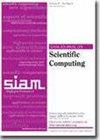A Framework for Implementing General Virtual Element Spaces
IF 2.6
2区 数学
Q1 MATHEMATICS, APPLIED
引用次数: 0
Abstract
SIAM Journal on Scientific Computing, Volume 46, Issue 3, Page B229-B253, June 2024.Abstract. In this paper we present a framework for the construction and implementation of general virtual element spaces based on projections built from constrained least squares problems. Building on the triples used for finite element spaces, we introduce the concept of a virtual element method (VEM) tuple which encodes the necessary building blocks to construct these projections. Using this approach, a wide range of virtual element spaces can be defined. We discuss [math]-conforming spaces for [math] as well as divergence and curl free spaces. This general framework has the advantage of being easily integrated into any existing finite element package, and we demonstrate this within the open source software package Dune. Reproducibility of computational results. This paper has been awarded the “SIAM Reproducibility Badge: Code and data available” as a recognition that the authors have followed reproducibility principles valued by SISC and the scientific computing community. Code and data that allow readers to reproduce the results in this paper are available at https://gitlab.dune-project.org/dune-fem/dune-vem-paper and in the supplementary materials (128492_2_supp_546442_s3hsrj.zip [22KB]).
实现通用虚拟元素空间的框架
SIAM 科学计算期刊》,第 46 卷第 3 期,第 B229-B253 页,2024 年 6 月。 摘要在本文中,我们提出了一个基于受约束最小二乘法问题建立的投影来构建和实现通用虚拟元素空间的框架。在用于有限元空间的三元组的基础上,我们引入了虚拟元素方法(VEM)元组的概念,它编码了构建这些投影的必要构件。利用这种方法,可以定义多种虚拟元素空间。我们讨论了[math]的[math]符合空间以及无发散和无卷曲空间。这种通用框架的优点是可以轻松集成到任何现有的有限元软件包中,我们在开源软件包 Dune 中演示了这一点。计算结果的可重复性。本文被授予 "SIAM 可再现性徽章":代码和数据可用",以表彰作者遵循了 SISC 和科学计算界重视的可重现性原则。读者可以通过 https://gitlab.dune-project.org/dune-fem/dune-vem-paper 和补充材料(128492_2_supp_546442_s3hsrj.zip [22KB])中的代码和数据重现本文的结果。
本文章由计算机程序翻译,如有差异,请以英文原文为准。
求助全文
约1分钟内获得全文
求助全文
来源期刊
CiteScore
5.50
自引率
3.20%
发文量
209
审稿时长
1 months
期刊介绍:
The purpose of SIAM Journal on Scientific Computing (SISC) is to advance computational methods for solving scientific and engineering problems.
SISC papers are classified into three categories:
1. Methods and Algorithms for Scientific Computing: Papers in this category may include theoretical analysis, provided that the relevance to applications in science and engineering is demonstrated. They should contain meaningful computational results and theoretical results or strong heuristics supporting the performance of new algorithms.
2. Computational Methods in Science and Engineering: Papers in this section will typically describe novel methodologies for solving a specific problem in computational science or engineering. They should contain enough information about the application to orient other computational scientists but should omit details of interest mainly to the applications specialist.
3. Software and High-Performance Computing: Papers in this category should concern the novel design and development of computational methods and high-quality software, parallel algorithms, high-performance computing issues, new architectures, data analysis, or visualization. The primary focus should be on computational methods that have potentially large impact for an important class of scientific or engineering problems.

 求助内容:
求助内容: 应助结果提醒方式:
应助结果提醒方式:


